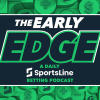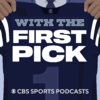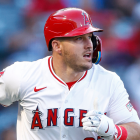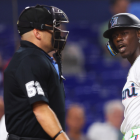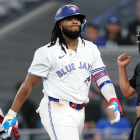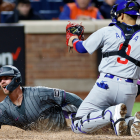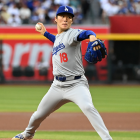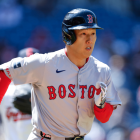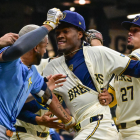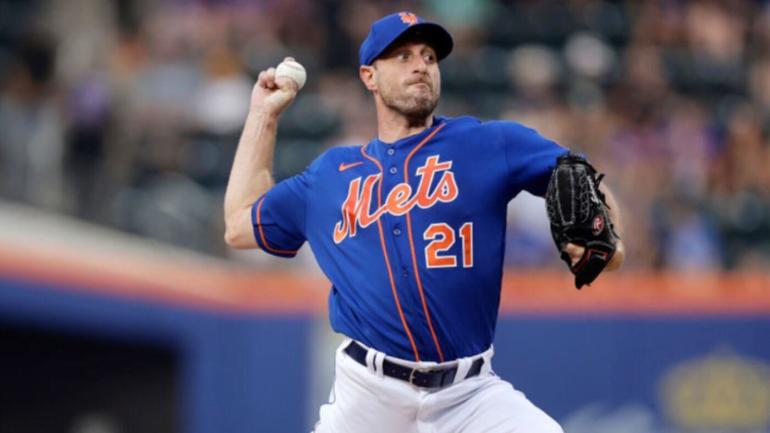
The Texas Rangers and New York Mets pulled off a trade deadline shocker on Saturday, agreeing to a deal that will send Max Scherzer and cash west in exchange for shortstop prospect Luisangel Acuña. Scherzer has since opted in to his 2024 player option worth more than $43 million, per ESPN's Jeff Passan. The Rangers, however, will be responsible for only $22.5 million of what's owed to Scherzer.
We here at CBS Sports are nothing if not judgmental. Part of our contribution to the thrill of the deadline is providing instant analysis, and putting a "grade" on how each team fared. Is this particularly wise if we want to be viewed well by forthcoming generations? Heavens no. But you have to give the people what they want, and sometimes what the people want is a good future laugh.
Here, again, are the full terms of the trade:
- Rangers receive: RHP Max Scherzer, cash considerations
- Mets receive: SS Luisangel Acuña
Now, onto the gasbaggery.
Rangers grade: A
Following professional sports in the social media age means gaining insight on narrative creation. You don't have to look to the horizon to sense when the cloudheads begin forming.
This season, overbrimming with preseason favorites going belly up, has been generous to the Take Havers. That's doubly true of the rough years authored by the Mets and Padres, the two franchises who've made the most splashy moves in recent years. Those clubs have led to a bevy of quips about the inherent shortcomings of super teams, and how you just cannot buy a championship. (No word on how, precisely, one can draft a title.) Whatever you make of the Mets and the Padres, the Rangers exist as a compelling counter to those claims.
These Rangers have made splash after splash after splash the last couple winters. They've signed Corey Seager, Marcus Semien, and Jacob deGrom from the top of the market. They've splurged on Nathan Eovaldi, Jon Gray, and Andrew Heaney from a tier or two below. Now, they've traded for Scherzer. On a related note, the Rangers have already won as many games as they did the entirety of the 2021 season, and will soon match their 2022 total. This from a franchise that has not put forth a winning campaign since the 2016 season. Perhaps accumulating talent, no matter the method, is the secret to success.
Scherzer certainly gives the Rangers an ace to replace the injured deGrom (a former Met himself) in name. What about in game? He's having an uncharacteristically down season, accumulating a 4.01 ERA (103 ERA+) and a 4.03 strikeout-to-walk ratio over his first 19 starts. Factor in the 10-game suspension he served after violating MLB's policy on grip-enhancing substances, and, well, it's been a year. The question here is simple: can Scherzer regain his elite form down the stretch?
A look at Scherzer's component measures suggests no -- not all the way. His velocity is down nearly a half tick. His strikeout rate is down nearly three percentage points. His walk rate is up more than two percentage points. He's not missing as many bats, and worse yet, he's not missing as many barrels. Need evidence? His exit velocity and hard-hit percentages are the worst they've been since 2015, when Statcast started tracking such data points.
It would be foolish to count out a three-time Cy Young Award winner who is known to possess Scherzer's passion and intelligence. At the same time, can you blame him if he's in decline? He's 39 years old and he's racked up a lot of mileage on that right arm. It's a compliment, not an insult,to suggest this evidently diminished form of Scherzer might be only above-average instead of elite. Loads of pitchers would gladly sign up for that being their new normal.
The Rangers are banking on Scherzer being rejuvenated by joining the team with the best run differential in the American League. They might prove right. If not? This edition of Scherzer should still be worthy of a spot in their playoff rotation, alongside Eovaldi, Gray, and whomever they prefer from a group that includes Dane Dunning, Martín Pérez, and Heaney.
You might wonder what Scherzer looks like next year, when he's even older and more, um, experienced. It's a fair question, but the Mets' financial assistance makes it an easier proposition to stomach. You know what would help even more? A deep postseason run that maybe, just maybe, ends with a parade.
The Fantasy Baseball Today podcast released an emergency episode to discuss the Scherzer deal. Listen below:
Mets grade: B
This is a gutsy move by the Mets in multiple respects. When they signed Scherzer the winter before last, they likely envisioned that he would someday make a hero's exit. Either this offseason (when he could've opted out had he 1) performed like his usual self and 2) considered the market to be flush) or next, he would depart having delivered a World Series championship, or, at least, a deep postseason run. Instead, they had to punt on those aspirations a season and a half in. Scherzer's Mets career, in turn, will entail 42 regular-season starts and a single playoff outing that saw him get drubbed by the Padres.
For that, we're docking the Mets' grade just a hair. We do think they did better here than we would've assumed they could've based on Scherzer's contract and performance by receiving a potential top-50 prospect in return. Accepting a sunk cost isn't easy. In this case, it's riskier than it appears. Remember, the Mets will be competing this winter for Shohei Ohtani's services alongside all the league's other high rollers. Ohtani is going to get paid regardless, suggesting that it might come down to which team he feels is best positioned to compete for a World Series title. The Mets, in trading one of their veteran aces, may have inadvertently given the Dodgers a leg up. Then again, maybe not. General manager Billy Eppler knows Ohtani better than any scribe. And besides, to quote general wisdom: scared money don't make money.
For now, let's put aside one form of hypotheticals for another: what, pray tell, the Mets hope becomes of the player they received in return.
What a week for @acunita13‼️
— Rangers Player Development (@TEXPlayerDev) April 24, 2023
The 21-year-old hit .360 with 3 2B, a grand slam and 2 stolen bases.
Acuña is hitting .323 with an .828 OPS thru 15 games this season for @RidersBaseball. pic.twitter.com/UfUSCUOMLR
Acuña, 21, is indeed the younger brother of Braves superstar Ronald. You're not likely to confuse the two for one another since Luisangel is shorter (he's listed at 5-foot-8) and can be found on the infield dirt rather than on the outfield grass. He's an intriguing talent all the same, as well as one who is in the midst of putting forth an above-average offensive season at the Double-A level. Through 84 games, he's batted .315/.377/.453 with seven home runs and 42 stolen bases (on 47 attempts).
Acuña has both a quick bat and a fast set of wheels. He's a good reminder that height doesn't always measure slugging potential -- not when the player in question possesses the appropriate amount of handspeed and loft. Acuña will need to refine his approach to maximize his pop. His 49.1% ground-ball percentage this season would be the lowest of his career, and he would be doing well to reduce that heading forward by further optimizing his swing decisions. Still, it's hard to knock him too much given his results.
Defensively, Acuña moves well and he has left-side arm strength. Francisco Lindor's presence at shortstop means that Acuña will likely change positions (or organizations) by the time he reaches the majors. In a vacuum, he could serve as a starting shortstop who can hit, run, and field. That's a quality player if you ask us.



